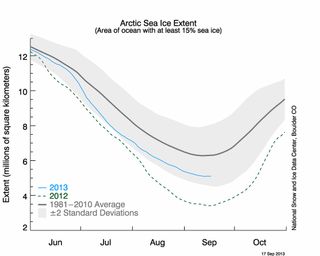
Arctic Sea Ice Closes In on Summer Low

The Arctic icepack appears to have reached its summer low this week. The annual summer melt season shrank the polar ice cap down to 5.10 million square kilometers (2.00 million square miles) on Sept. 16, according to the National Snow & Ice Data Center (NSIDC) in Boulder, Colo. Now, NSIDC scientists are tracking the Arctic icepack's shifting boundaries via satellite to confirm whether the Sept. 16 extent was the minimum, a spokeswoman for the research center said. The ice can wax and wane before heading into the fall refreeze.
This year saw much more ice cover than 2012, which set an all-time record for the lowest summer ice extent. The Northwest Passage was closed for the first time since 2007. But if Sept. 16 was the summer low, then 2013 was still a sixth place finisher for the lowest amount of summer ice since record-keeping started in the Arctic 30 years ago. And the overall volume of ice — a measure of its thickness — continues to decrease as well.
Climate models predict that climate change will cause large variations in the summer ice from year to year, according to a statement from the NSIDC. This year, cool summer weather in the Arctic helped the ice stick around for the summer, the NSIDC said. Air temperatures were colder than average in the Arctic, which helps retain a thin layer of ice, increasing the overall ice extent.
Email Becky Oskin or follow her @beckyoskin. Follow us @livescience, Facebook & Google+.
Sign up for the Live Science daily newsletter now
Get the world’s most fascinating discoveries delivered straight to your inbox.

Most Popular



